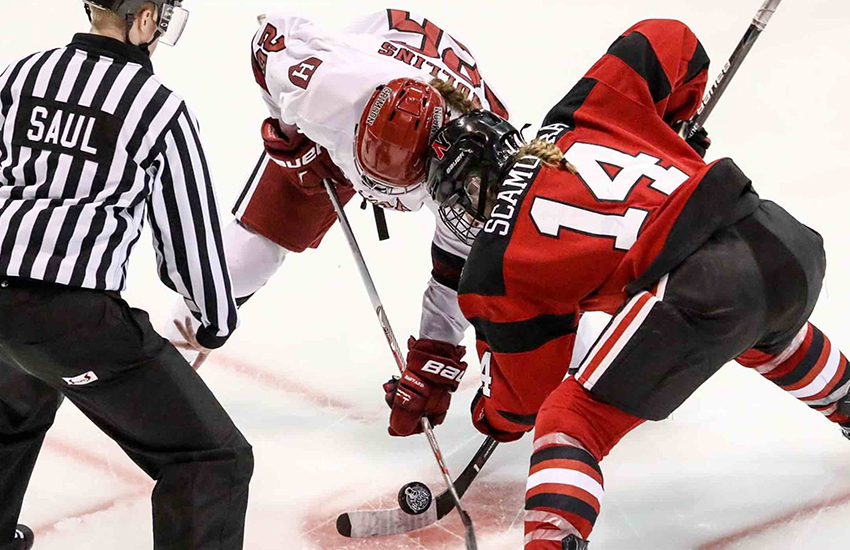Hockey is a high-speed, physical sport that demands a lot from its players. With body checking, stick fighting, and high-impact collisions, hockey players are always at risk for injuries.
While some injuries are more common than others, any injury can have significant consequences on a player’s performance and the outcome of a game.
In this blog, we will take a look at the most common injuries in hockey, including concussions, knee injuries, shoulder injuries, ankle injuries, wrist injuries, hip injuries, and back injuries. We will explore how these injuries can impact a player’s performance and how they can affect the outcome of a game.
Additionally, we will examine the betting implications of these injuries, as sports bettors must take injuries into account when making their wagers. Whether you’re a hockey fan or a sports bettor, understanding the most common hockey injuries and their implications can give you an edge in predicting game outcomes and making informed bets.
Concussions
Concussions are a serious brain injury in hockey and can have a significant impact on a team’s performance, which in turn can affect the game’s outcome.
When a player suffers a concussion, they are often required to go through a concussion protocol and may be sidelined for a period of time. This can affect the team’s overall lineup and potentially disrupt the chemistry of the team. Additionally, if the player who suffers a concussion is a key player or a star player, their absence can significantly impact the team’s offensive and defensive production.
Furthermore, concussions can also affect a player’s physical and cognitive abilities, which can make it more difficult for them to perform at their best. For example, they may experience headaches, dizziness, or difficulty concentrating, which can impact their skating, shooting, and decision-making abilities.
Overall concussions can have a ripple effect on a team’s performance, and ultimately affect the game’s outcome. If a team is missing a key player due to a concussion or other injury, they may be less likely to win the game or may not perform at their best. As a result, it’s important to take injuries into consideration when making predictions or betting on the outcome of a game.
Knee Injuries
Knee injuries are a common occurrence in hockey and can have a significant impact on a player’s ability to perform, which can ultimately affect the game’s outcome.
When a player suffers a knee injury, such as a sprain or tear of the ligaments or cartilage, they are usually required to undergo a period of rest and rehabilitation before returning to play. During this time, the player may be sidelined for several games or even weeks, which can impact the team’s lineup and overall performance. In addition, knee injuries can affect a player’s mobility, stability, and agility on the ice, which can have a significant impact on their performance. For example, a player may have difficulty with skating, pivoting, or changing direction, which can impact their ability to defend or score.
Furthermore, if the player who suffers a knee injury is a key player or a star player, their absence can significantly impact the team’s offensive and defensive production. This can have a ripple effect on the team’s overall performance and potentially lead to a lower chance of winning the game.
Shoulder Injuries
Shoulder injuries are another common injury in hockey that can have a significant impact on a player’s ability to perform, which can ultimately affect the game’s outcome. When a player suffers a shoulder injury, such as a dislocation or separation, they may be required to undergo a period of rest and rehabilitation before returning to play.
During this time, the player may be sidelined for several games or even weeks, which can impact the team’s lineup and overall performance. In addition, shoulder injuries can affect a player’s ability to engage in physical play and perform tasks such as body checking, which can impact their ability to defend or create scoring opportunities.
Additionally, if the injured player is a key player or a star player, their absence can significantly impact the team’s offensive and defensive production. Furthermore, shoulder injuries can also affect a player’s ability to shoot and pass accurately, which can have a significant impact on the team’s overall performance and their ability to score goals.
Ankle Injuries
Ankle injuries are also a common occurrence in hockey and can have a significant impact on a player’s ability to perform, which can ultimately affect the game’s outcome.
When a player suffers an ankle injury, such as a sprain or fracture, they are usually required to undergo a period of rest and rehabilitation before returning to play. During this time, the player may be sidelined for several games or even weeks, which can impact the team’s lineup and overall performance.
In addition, ankle injuries can affect a player’s ability to skate and maneuver on the ice, which can have a significant impact on their performance. For example, they may have difficulty with turns, stops, or acceleration, which can impact their ability to defend or create scoring opportunities.
Furthermore, if the injured player is a key player or a star player, their absence can significantly impact the team’s offensive and defensive production, which can ultimately affect the game’s outcome.
Wrist Injuries

Wrist injuries are another common injury in hockey that can have a significant impact on a player’s ability to perform, which can ultimately affect the game’s outcome. When a player suffers a wrist injury, such as a sprain or fracture, they are usually required to undergo a period of rest and rehabilitation before returning to play.
During this time, the player may be sidelined for several games or even weeks, which can impact the team’s lineup and overall performance. In addition, wrist injuries can affect a player’s ability to stick handle, shoot, and pass accurately, which can have a significant impact on the team’s offensive production. For example, a player may have difficulty controlling the puck or generating power on their shot, which can impact their ability to score goals or create scoring opportunities.
Furthermore, if the injured player is a key player or a star player, their absence can significantly impact the team’s offensive production and their ability to score goals, which can ultimately affect the game’s outcome.
Back Injuries
Back injuries are another common injury in hockey that can have a significant impact on a player’s ability to perform, which can ultimately affect the game’s outcome.
When a player suffers a back injury, such as a strain or herniated disc, they may be required to undergo a period of rest and rehabilitation before returning to play. During this time, the player may be sidelined for several games or even weeks, which can impact the team’s lineup and overall performance.
When a player suffers a back injury, such as a strain or herniated disc, they may be required to undergo a period of rest and rehabilitation before returning to play. During this time, the player may be sidelined for several games or even weeks, which can impact the team’s lineup and overall performance.
Furthermore, if the injured player is a key player or a star player, their absence can significantly impact the team’s offensive and defensive production, which can ultimately affect the game’s outcome.
Hip Injuries
Hip injuries are less common in hockey, but they can still have a significant impact on a player’s ability to perform, which can ultimately affect the game’s outcome. When a player suffers a hip injury, such as a strain or fracture, they may be required to undergo a period of rest and rehabilitation before returning to play.
During this time, the player may be sidelined for several games or even weeks, which can impact the team’s lineup and overall performance. In addition, hip injuries can affect a player’s ability to skate and maneuver on the ice, which can impact their ability to defend or create scoring opportunities.
They may also experience pain or discomfort while skating or during physical play, which can further impact their performance. Furthermore, if the injured player is a key player or a star player, their absence can significantly impact the team’s offensive and defensive production, which can ultimately affect the game’s outcome.






